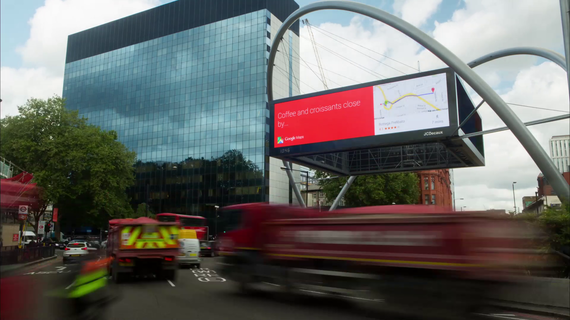
Source: Grand Visual
The once humble billboard, now a connected powerhouse, looks set to play a key role in the future of smart city infrastructure. The digitisation of the Out of Home media landscape continues apace and provides an important entry point for reaching hyper-connected urban audiences with real-time news and information, alongside smart, contextual, data-driven advertising.
For advertisers, never before has there been so much opportunity to target on-the-go audiences. The ubiquity of full-motion Digital Out of Home (DOOH) screens in cities around the world, combined with rocketing smartphone penetration, wifi provision, and a growing tech-savvy OOH audience, all provide a huge amount of data to inform outdoor creative. Advertisers should be looking at OOH through a new strategic lens.
In fact, we can harness a vast range of data to contextualise OOH copy. There's location data, and 3rd party data such as weather, social, transit, and news, plus brand owned data including pricing, stock levels, and retail stores. Through these layers of data, we can exploit the 'Context Effect' - providing dynamic, data-driven and locally relevant information throughout the customer journey - powerful.
This year there has been some promising signs that the creative mode is moving in the right direction. The datasets have expanded beyond the pure daypart and weather activations that informed DOOH creative in 2015. Campaigns utilising sports data or social media triggers (trends, polls, competitions, direct interaction) have been particularly prevalent, but there has also been cinema listings, traffic reports, pollution levels, travel times, BARB data, and car recognition technology used to inform DOOH creative.
Notable examples from this year include the NSW Cancer Institute using real-time UV levels to deliver sun-safe messages in Australia, Amazon's people-powered DOOH activity for Catastrophe in the US, which used live twitter polls to trigger themed trailers based on audience preference.
In the UK, the charity Missing People used live registration statistics from its Child Rescue Alert campaign, alongside location and travel data, to deliver real-time, geo-targeted messages. Google's long-term holding at Old Street roundabout continues to deliver real-time locally relevant information about traffic conditions, weather, nearest cafes, as well as being a living, breathing noticeboard for the East London community.
However, the reality is, we might all be talking about it, but when it comes to harnessing the power of data in the DOOH environment, good examples are still relatively light on the ground. Most campaigns remain one-dimensional, few have leveraged brand owned data or used different datasets to target different touch points during the customer journey. There is definite room for growth here. DOOH could be doing so much more.
The DOOH platform can automate delivery, prioritising advertising which matches pre-set conditions such as time, weather and consumer mindset. For a soft drinks portfolio - this could mean pushing hydrating iced tea on a hot summer's day, fresh juice and caffeinated drinks during the morning commute, isotonic drinks on gym screens, and details of mixers and cocktails for those heading home after a long day in the office.
Targeting efficiency should also be brought into brand messages as well as media placements, whether that's tapping into major events, sports tournaments, or topics trending on Twitter. Creative can also target audience segments and mindsets - targeting mums with coffee brands and local cafes during the morning, lunch deals targeting office workers based on the weather, such as soup for cold days, followed by drinks deals available at club nights in the evenings.
Given the serious amount of data available to contextualise copy, it seems strange that DOOH is still lagging behind online in its use of data. The main components of delivering a successful data-informed campaign include; shared ambition, clean, accessible, real-time data, and ad-tech systems to process and deliver copy based on conditions.
The ambition to be more tactical, more relevant and more effective is a given for any brand. Plus, the impressive ROI studies that are starting to amass for data-driven, contextual OOH campaigns makes it a no-brainer. The systems to analyse, manage and deliver real-time data-driven campaigns are already in place with ad-tech platforms such as OpenLoop.
So, that leaves data, and one of the key challenges for 2017 will be finding clean data sources that are accessible in real-time. Data moves extremely fast and a lot of cities are now looking at all the data that gets produced by various systems and how the data is captured. This goes for brands too, as they look to be more strategic in their customer engagement and targeting ability, data streams will become more and more important going forward.
DOOH advertising is in rude health. It cannot be muted, blocked or skipped and provides important touchpoints during the customer journey right up to the point of purchase. The proliferation of devices and data means that advertising messages can now be targeted, tactical and relevant throughout the day. This year has shown some promising signs that the sector is waking up to the opportunity, and we are excited to see where data leads us creatively in 2017.